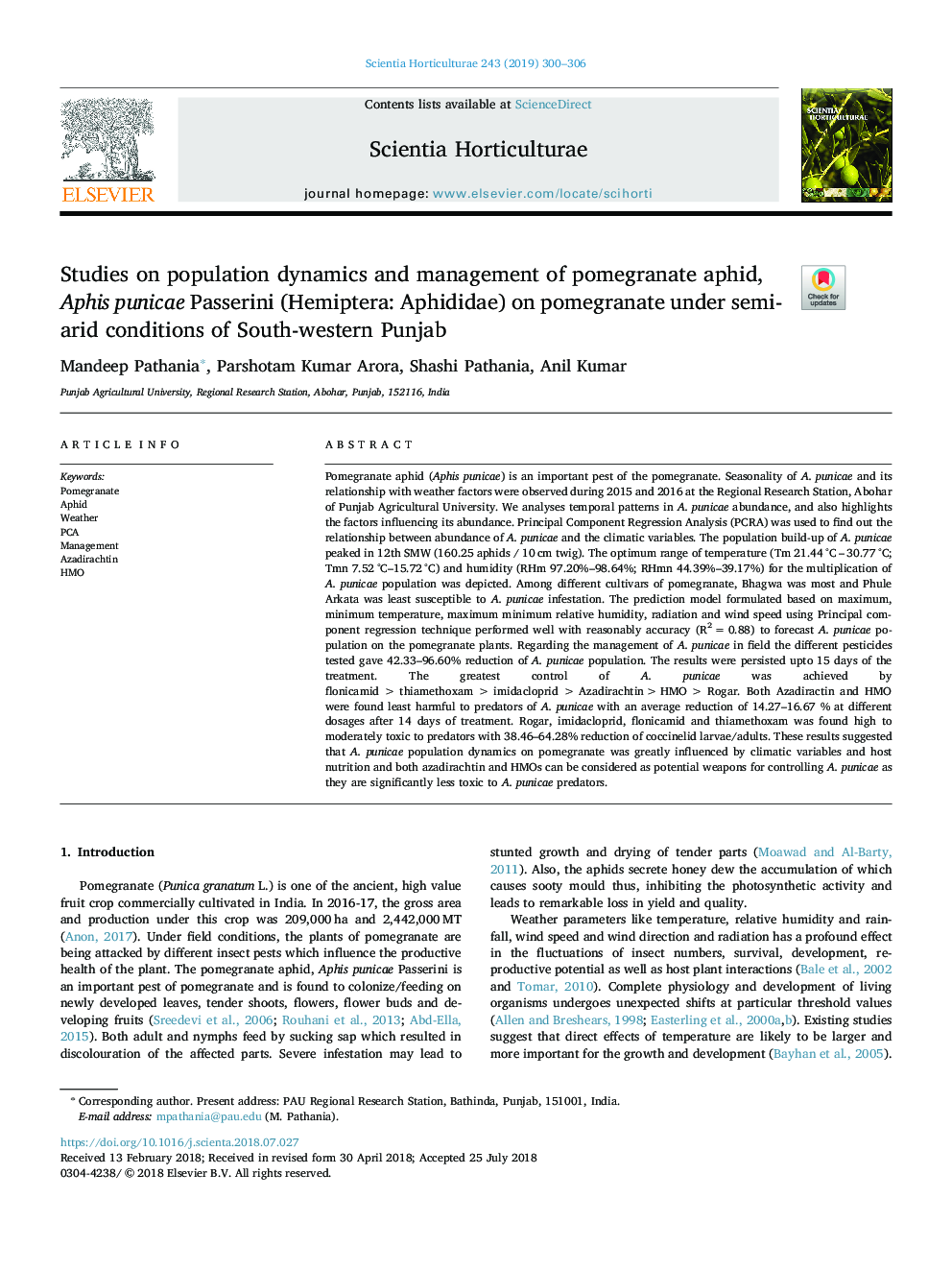| کد مقاله | کد نشریه | سال انتشار | مقاله انگلیسی | نسخه تمام متن |
|---|---|---|---|---|
| 9489589 | 1628755 | 2019 | 7 صفحه PDF | دانلود رایگان |
عنوان انگلیسی مقاله ISI
Studies on population dynamics and management of pomegranate aphid, Aphis punicae Passerini (Hemiptera: Aphididae) on pomegranate under semi-arid conditions of South-western Punjab
دانلود مقاله + سفارش ترجمه
دانلود مقاله ISI انگلیسی
رایگان برای ایرانیان
کلمات کلیدی
موضوعات مرتبط
علوم زیستی و بیوفناوری
علوم کشاورزی و بیولوژیک
دانش باغداری
پیش نمایش صفحه اول مقاله

چکیده انگلیسی
Pomegranate aphid (Aphis punicae) is an important pest of the pomegranate. Seasonality of A. punicae and its relationship with weather factors were observed during 2015 and 2016 at the Regional Research Station, Abohar of Punjab Agricultural University. We analyses temporal patterns in A. punicae abundance, and also highlights the factors influencing its abundance. Principal Component Regression Analysis (PCRA) was used to find out the relationship between abundance of A. punicae and the climatic variables. The population build-up of A. punicae peaked in 12th SMW (160.25 aphids / 10âcm twig). The optimum range of temperature (Tm 21.44â°Câ-â30.77â°C; Tmn 7.52â°C-15.72â°C) and humidity (RHm 97.20%-98.64%; RHmn 44.39%-39.17%) for the multiplication of A. punicae population was depicted. Among different cultivars of pomegranate, Bhagwa was most and Phule Arkata was least susceptible to A. punicae infestation. The prediction model formulated based on maximum, minimum temperature, maximum minimum relative humidity, radiation and wind speed using Principal component regression technique performed well with reasonably accuracy (R2â=â0.88) to forecast A. punicae population on the pomegranate plants. Regarding the management of A. punicae in field the different pesticides tested gave 42.33-96.60% reduction of A. punicae population. The results were persisted upto 15 days of the treatment. The greatest control of A. punicae was achieved by flonicamidâ>âthiamethoxamâ>âimidaclopridâ>âAzadirachtin> HMOâ>âRogar. Both Azadiractin and HMO were found least harmful to predators of A. punicae with an average reduction of 14.27-16.67 % at different dosages after 14 days of treatment. Rogar, imidacloprid, flonicamid and thiamethoxam was found high to moderately toxic to predators with 38.46-64.28% reduction of coccinelid larvae/adults. These results suggested that A. punicae population dynamics on pomegranate was greatly influenced by climatic variables and host nutrition and both azadirachtin and HMOs can be considered as potential weapons for controlling A. punicae as they are significantly less toxic to A. punicae predators.
ناشر
Database: Elsevier - ScienceDirect (ساینس دایرکت)
Journal: Scientia Horticulturae - Volume 243, 3 January 2019, Pages 300-306
Journal: Scientia Horticulturae - Volume 243, 3 January 2019, Pages 300-306
نویسندگان
Mandeep Pathania, Parshotam Kumar Arora, Shashi Pathania, Anil Kumar,